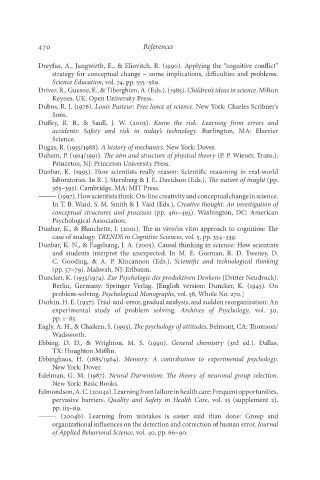Page 487 - Deep Learning
P. 487
470 References
Dreyfus, A., Jungwirth, E., & Eliovitch, R. (1990). Applying the “cognitive conflict”
strategy for conceptual change – some implications, difficulties and problems.
Science Education, vol. 74, pp. 555–569.
Driver, R., Guesne, E., & Tiberghien, A. (Eds.). (1985). Children’s ideas in science. Milton
Keynes, UK: Open University Press.
Dubos, R. J. (1976). Louis Pasteur: Free lance of science. New York: Charles Scribner’s
Sons.
Duffey, R. B., & Saull, J. W. (2003). Know the risk. Learning from errors and
accidents: Safety and risk in today’s technology. Burlington, MA: Elsevier
Science.
Dugas, R. (1955/1988). A history of mechanics. New York: Dover.
Duhem, P. (1914/1991). The aim and structure of physical theory (P. P. Wiener, Trans.).
Princeton, NJ: Princeton University Press.
Dunbar, K. (1995). How scientists really reason: Scientific reasoning in real-world
laboratories. In R. J. Sternberg & J. E. Davidson (Eds.), The nature of insight (pp.
365–395). Cambridge, MA: MIT Press.
———. (1997). How scientists think: On-line creativity and conceptual change in science.
In T. B. Ward, S. M. Smith & J. Vaid (Eds.), Creative thought: An investigation of
conceptual structures and processes (pp. 461–493). Washington, DC: American
Psychological Association.
Dunbar, K., & Blanchette, I. (2001). The in vivo/in vitro approach to cognition: The
case of analogy. TRENDS in Cognitive Sciences, vol. 5, pp. 334–339.
Dunbar, K. N., & Fugelsang, J. A. (2005). Causal thinking in science: How scientists
and students interpret the unexpected. In M. E. Gorman, R. D. Tweney, D.
C. Gooding, & A. P. Kincannon (Eds.), Scientific and technological thinking
(pp. 57–79). Mahwah, NJ: Erlbaum.
Duncker, K. (1935/1974). Zur Psychologie des produktiven Denkens (Dritter Neudruck).
Berlin, Germany: Springer Verlag. [English version: Duncker, K. (1945). On
problem-solving. Psychological Monographs, vol. 58, Whole No. 270.]
Durkin, H. E. (1937). Trial-and-error, gradual analysis, and sudden reorganization: An
experimental study of problem solving. Archives of Psychology, vol. 30,
pp. 1–85.
Eagly, A. H., & Chaiken, S. (1993). The psychology of attitudes. Belmont, CA: Thomson/
Wadsworth.
Ebbing, D. D., & Wrighton, M. S. (1990). General chemistry (3rd ed.). Dallas,
TX: Houghton Mifflin.
Ebbinghaus, H. (1885/1964). Memory: A contribution to experimental psychology.
New York: Dover.
Edelman, G. M. (1987). Neural Darwinism: The theory of neuronal group selection.
New York: Basic Books.
Edmondson, A. C. (2004a). Learning from failure in health care: Frequent opportunities,
pervasive barriers. Quality and Safety in Health Care, vol. 13 (supplement 2),
pp. ii3–ii9.
———. (2004b). Learning from mistakes is easier said than done: Group and
organizational influences on the detection and correction of human error. Journal
of Applied Behavioral Science, vol. 40, pp. 66–90.

